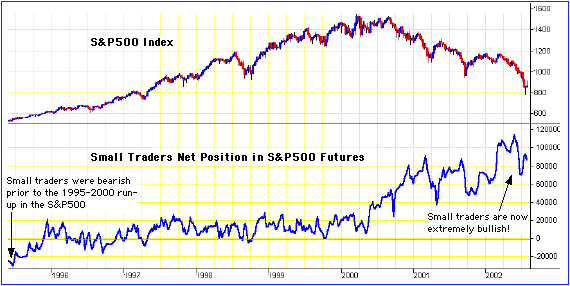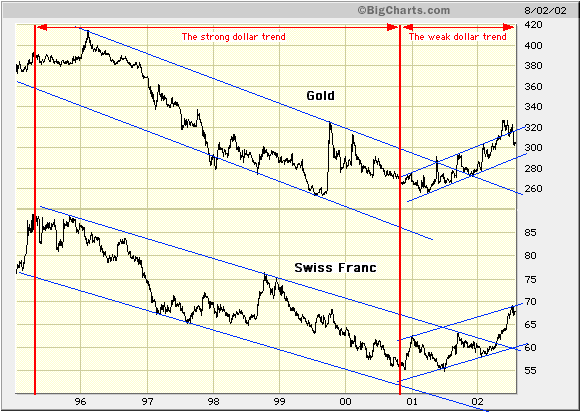
Stocks and
Gold
The stock
market's sentiment problem
The stock market has a sentiment problem
because, despite the huge declines over the past 2 years in many of the
high-profile stock indices, the public remains generally bullish on the
market. This 'sentiment problem' is encapsulated by the following chart
showing the net-position of small traders (a.k.a. the 'public' or the 'dumb
money') in S&P500 futures contracts. This chart has dramatic implications.

Chart courtesy of Nick Laird at www.sharelynx.net
The small traders - the ones who are
most often wrong and who were, as a group, bearish on the market
in early-1995 (just prior to a phenomenal 5-year rally) - have become progressively
more bullish over the past 2 years as the market has fallen. We
can't over-emphasise how unusual this is. Small traders, as a group, almost
always become more bullish as prices rise and more bearish as prices fall.
As such, they will tend to reach their maximum long position near major
market tops and reach their maximum short position near major market bottoms.
In other words, the net position of small traders in the stock-index futures
market is a contrary indicator - when the small traders become very bullish
it is usually a sign that the market is about to go down and when they
become very bearish it is a sign that the market is about to rally.
The main implication of the above chart
is that we are still in the denial stage of this bear market (most
people are still thinking in terms of the downturn in the stock market
being a correction within a long-term bull market rather than a change
in the long-term trend). This, in turn, means that the target of 800 for
the S&P500 Index that we came up with at the beginning of this year
is not even going to be in the same ballpark as the ultimate bear-market
low. The S&P500 Index has already traded below 800 yet the general
public still doesn't believe the long-term trend has changed. First of
all the market will have to fall far enough to convince the majority of
people that we are not just experiencing a correction within a long-term
bull trend. Only then will the capitulation phase of the bear market begin.
Unfortunately, based on what has happened over the past 6 months it appears
that the capitulation phase won't even start until the S&P500
has fallen well below 800.
In summary, it is highly probable that
the stock market is going MUCH lower, with the only question being when.
Outside of gold and silver stocks an investor's exposure to the stock market
should therefore be kept small in relation to their net worth.
Gold versus
the US Dollar
Like all investments or stores of value,
gold's relative worth is determined by how attractive it appears to be
compared to the alternatives. The alternatives to gold are the paper currencies
of the world in general and the US$ in particular. The major influence
on the gold price is therefore the level of confidence in the US$ and other
paper currencies. Put another way, the investment demand for gold (and
therefore the gold price) will languish when there is a high level of confidence
that the US$ and the other currencies of the world will provide attractive
real returns on investment. Conversely, the investment demand for gold
will be strong when there is little confidence that the competing forms
of money can provide a satisfactory return on investment.
The US$ is the linchpin of the world's
current monetary system and, as such, it is gold's main competitor. As
long as the US$ is perceived to be a strong currency there is little incentive
for most people to invest in gold. However, when the US$ falls out of favour
gold tends to come into favour. This is clearly illustrated by the following
chart comparing the gold price and the Swiss Franc (SF). It is not coincidental
that gold's current bull market can be traced back to October of 2000,
the month that the SF made a long-term bottom against the US$ and embarked
on a bull market of its own.

Regular financial market forecasts
and
analyses are provided at our web site:
http://www.speculative-investor.com/new/index.html
One-month free trial available.

|

